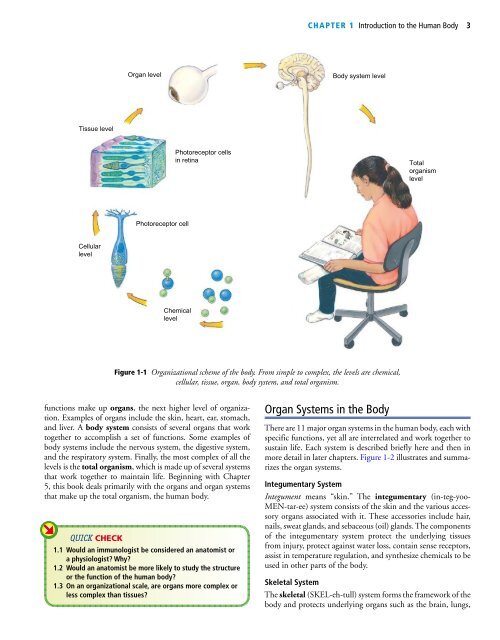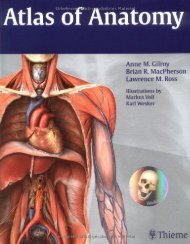theanatomyandphysiologylearningsystem4epdfdr-150930024720-lva1-app6891
You also want an ePaper? Increase the reach of your titles
YUMPU automatically turns print PDFs into web optimized ePapers that Google loves.
Chapter 1 Introduction to the Human Body 3<br />
Organ level<br />
Body system level<br />
Tissue level<br />
Photoreceptor cells<br />
in retina<br />
Total<br />
organism<br />
level<br />
Photoreceptor cell<br />
Cellular<br />
level<br />
Chemical<br />
level<br />
Figure 1-1 Organizational scheme of the body. From simple to complex, the levels are chemical,<br />
cellular, tissue, organ, body system, and total organism.<br />
functions make up organs, the next higher level of organization.<br />
Examples of organs include the skin, heart, ear, stomach,<br />
and liver. A body system consists of several organs that work<br />
together to accomplish a set of functions. Some examples of<br />
body systems include the nervous system, the digestive system,<br />
and the respiratory system. Finally, the most complex of all the<br />
levels is the total organism, which is made up of several systems<br />
that work together to maintain life. Beginning with Chapter<br />
5, this book deals primarily with the organs and organ systems<br />
that make up the total organism, the human body.<br />
Quick Check<br />
1.1 Would an immunologist be considered an anatomist or<br />
a physiologist? Why?<br />
1.2 Would an anatomist be more likely to study the structure<br />
or the function of the human body?<br />
1.3 On an organizational scale, are organs more complex or<br />
less complex than tissues?<br />
Organ Systems in the Body<br />
There are 11 major organ systems in the human body, each with<br />
specific functions, yet all are interrelated and work together to<br />
sustain life. Each system is described briefly here and then in<br />
more detail in later chapters. Figure 1-2 illustrates and summarizes<br />
the organ systems.<br />
Integumentary System<br />
Integument means “skin.” The integumentary (in-teg-yoo-<br />
MEN-tar-ee) system consists of the skin and the various accessory<br />
organs associated with it. These accessories include hair,<br />
nails, sweat glands, and sebaceous (oil) glands. The components<br />
of the integumentary system protect the underlying tissues<br />
from injury, protect against water loss, contain sense receptors,<br />
assist in temperature regulation, and synthesize chemicals to be<br />
used in other parts of the body.<br />
Skeletal System<br />
The skeletal (SKEL-eh-tull) system forms the framework of the<br />
body and protects underlying organs such as the brain, lungs,

















